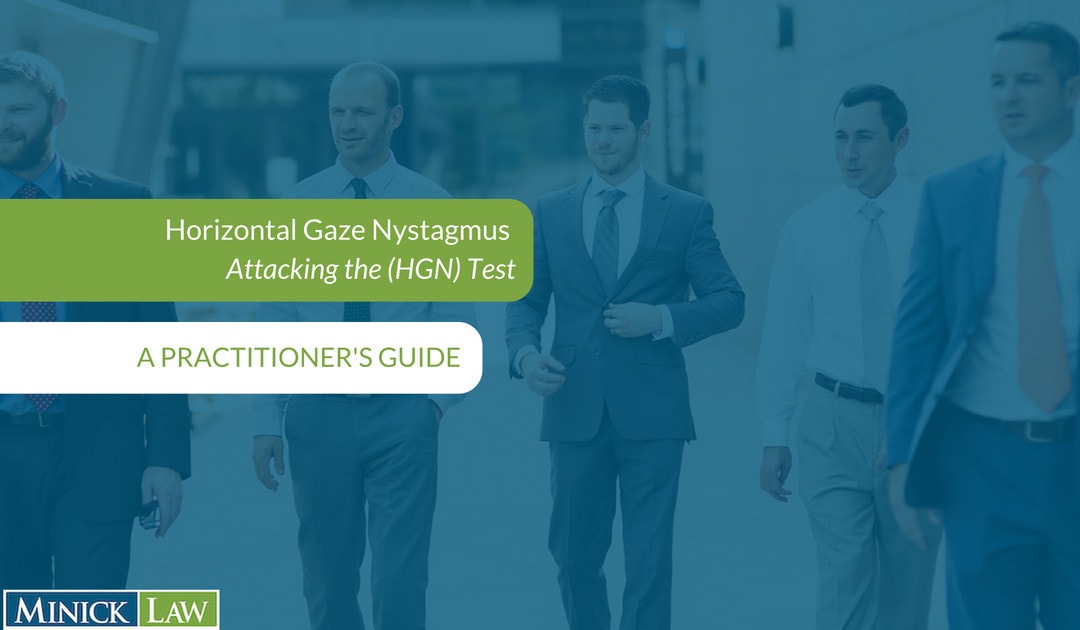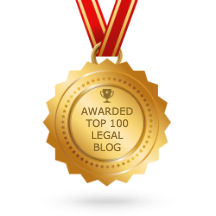
Attorney James Minick of Minick Law, P.C.
Attacking the Horizontal Gaze Nystagmus HGN Test: A Guide For North Carolina Practitioners
This blog is written for North Carolina attorneys looking to attack the admissibility of the Horizontal Gaze Nystagmus (HGN) test in North Carolina Courts.
CASE UPDATE: In April 2016 the North Carolina Court of Appeals decided two cases dealing with HGN Testimony. State v. Godwin, No. COA15-766 (2016); State v. Torrence, No. COA15-949 (2016).
In Godwin, the Court of Appeals ruled that the “trial court erred in allowing a witness who had not been qualified as an expert under Rule 702(a) to testify as to the issue of impairment based on the HGN test results.” The Court hinted that its ruling in State v. Smart (addressed below) might not have survived the amendments to Rule 702, but did not rule as such since it found Smart irrelevant to the legal issues presented in Godwin. This holding in Godwin makes explicit what we have argued is implicit in the amendments to Rule 702 in the article below.
In Torrence, the Court of Appeals utilized its ruling in Godwin (published the same day), to find that Rule 702 requires a witness testifying to HGN to be qualified as an expert. Moreover, in Torrence, the officer testifying about HGN stated that “there was a 77% chance that the defendant’s blood alcohol level was .10 or higher” based on the results of HGN. The court found that this testimony violated Rule 702(a1) “because he testified on the issue of specific alcohol concentration level relating to the results of the HGN test.”
The article below provides a good framework and history of Rule 702 as applied to HGN testimony, but the recent rulings in Godwin and Torrence are critical to properly attacking HGN testimony.
North Carolina Rule 702(a) – Testimony by an Expert
To attack the admissibility of HGN, it is important to look at when scientific, technical or specialized knowledge (i.e. expert testimony) is admissible in NC.
Rule 702(a) states that if scientific, technical or other specialized knowledge will assist the judge or jury on a factual issue, then an expert may testify in the form of an opinion, if:
- The testimony is based upon sufficient facts or data;
- The testimony is the product of reliable principles and methods; AND
- The witness has applied the principles and methods reliably to the facts of the case.
Each of these prongs of 702(a) is discussed in the sections below.
NC Rule 702(a1) – HGN Testimony
NC Rule 702 specifically states that an expert witness, qualified under 702(a) and who has completed HGN training, can give an opinion solely on the issue of impairment, and not on the issue of a specific alcohol concentration level, based on the results of a HGN test.
Testimony Must Be Based Sufficiency of Facts and Data
This may be the most difficult prong of Rule 702(a) to attack in regards to the admissibility of HGN testing. This prong of rule 702 examines the witness’ knowledge of the HGN testing in the case at issue.
Cross-examination questions designed to attack that HGN testimony is based on sufficient facts or data might include:
- What other clues of impairment were observed?
- Has the expert reviewed medical records of the suspect?
- How much does the expert know about the ocular medical history of the suspect?
- Were other field sobriety tests performed or did the arresting officer perform only the HGN?
- Is the expert witness the one that actually performed the HGN test? If not, how much information was the expert witness given about the way in which the HGN test was performed on the suspect in the field? Was he there? Has he seen video? Has he been given copies of the officer’s field notes to review?
Testimony Must be the Product of Reliable Principles and Methods
This prong of 702 addresses whether HGN testing itself is the product of reliable principles and methods. Most officers performing HGN have very little training on how HGN came into use or the science behind HGN. They are technicians trained to perform HGN; they are typically not trained to defend the reliability of HGN testing. The reliability of HGN is generally assumed by the officer performing HGN.
The North Carolina appellate courts have been inconsistent on the evidence necessary from the State to satisfy the reliability prong of Rule 702(a). The NC Supreme Court has found that unless the Court takes judicial notice as to the reliability of the HGN test, the State must present evidence showing HGN testing to be reliable. See State v. Helms, 348 N.C. 578 (1998). However, the NC Court of Appeals later found that pre-2011 Rule 702(a1) obviated the need for the State to establish that HGN testing was reliable. State v. Smart, 195 N.C. App. 752 (2009). Both of these HGN cases were decided prior to Rule 702’s revision in 2011.
There is very limited studies and research to show that HGN testing is an accurate indicator of appreciable impairment (i.e. where does a person fit on the drunk scale). Instead, almost all the NHTSA studies have been conducted with the intent of showing the reliability of HGN testing in predicting a person’s Blood Alcohol Concentration (BAC) level. Since Rule 702(a1) prohibits expert testimony as to a specific BAC concentration, it could be argued that HGN testing should be excluded altogether under amended Rule 702(a1)[see section Solely on Issue of Impairment below for further discussion].
Cross-examination questions designed to attack that HGN testing is the product of reliable principles and methods might include:
- Are you familiar the Colorado Validation Study of Standardized Field Sobriety Test Battery? Do you recall discussing this study during Session 8 of your NHTSA DWI Detection and Standardized Field Sobriety Testing training? (In the 2006 Edition of the NHTSA Student Manual this study is Attachment B to Session 8; in the 2013 Edition of the Student Manual this study is discussed on page 9 Session 8) Have you read this study?
- Are you familiar the Florida Validation Study of the Standardized field Sobriety Test Battery? Do you recall discussing this study Session 8 of your NHTSA DWI Detection and Standardized Field Sobriety Testing training? (In the 2006 Edition of the NHTSA Student Manual this study is Attachment C to Session 8; in the 2013 Edition of the Student Manual this study is discussed on page 9 Session 8) Have you read this study?
- Are you familiar the Validation of the Standardized Field Sobriety Test Battery at BACs Below 0.10%? Do you recall discussing this study Session 8 of your NHTSA DWI Detection and Standardized Field Sobriety Testing training? (In the 2006 Edition of the NHTSA Student Manual this study is Attachment D to Session 8; in the 2013 Edition of the Student Manual this study is discussed on page 10 Session 8) Have you read this study?
- How were the NHTSA principles and methods for HGN testing created?
- What is the difference between a test being reliability and a test being valid (reliability v. validity)?
- How do you know they are reliable?
- Do you know where the studies were performed (in a classroom setting, a laboratory, in the field)?
- Do you know the conditions under which the studies were performed?
- Do you know if the officers conducting HGN tests in the validation studies were rookie officers, DREs, in between, or all of the above?
- Do you know if the subjects in the field validations studies were part of a controlled drinking exercise or if they were real suspects being investigated for DWI?
- Do you know how many of the subjects were found to have alcohol in their system?
- Do you know the error rate for false positives on HGN?
Are there other causes of nystagmus? Are you aware that the Supreme Court of North Carolina has referenced thirty eight causes of nystagmus other than alcohol intoxication? See State v. Helms, 348 N.C. 578 (1998) (citing Schultz v. State, 106 Md. App. 145 (1995)). The causes referenced in Shultz are:
(1) problems with the inner ear labyrinth; (2) irrigating the ears with warm or cold water under peculiar weather conditions; (3) influenza; (4) streptococcus infection; (5) vertigo; (6) measles; (7) syphilis; (8) arteriosclerosis; (9) muscular dystrophy; (10) multiple sclerosis; (11) Korchaff’s syndrome; (12) brain hemorrhage; (13) epilepsy; (14) hypertension; (15) motion sickness; (16) sunstroke; (17) eye strain; (18) eye muscle fatigue; (19) glaucoma; (20) changes in atmospheric pressure; (21) consumption of excessive amounts of caffeine; (22) excessive exposure to nicotine; (23) aspirin; (24) circadian rhythms; (25) acute trauma to the head; (26) chronic trauma to the head; (27) some prescription drugs, tranquilizers, pain medications, anticonvulsants; (28) barbiturates; (29) disorders of the vestibular apparatus and brain stem; (30) cerebellum dysfunction; (31) heredity; (32) diet; (33) toxins; (34) exposure to solvents, PCBS, dry cleaning fumes, carbon monoxide; (34) extreme chilling; (35) eye muscle imbalance; (36) lesions; (37) continuous movement of the visual field past the eyes, i.e., looking from a moving train; (38) antihistamine use.
The officer could be questioned on how he has been trained to differentiate these causes of nystagmus from Horizontal Gaze Nystagmus (HGN), for example:
How does nystagmus caused by inner ear disorders differ from horizontal gaze nystagmus?
The National Highway Traffic Safety Administration agrees that “[n]ystagmus may be due to causes other than alcohol. These other causes include seizure and some other drugs. A large disparity between the performance of the right eye and left eye may indicate a medical condition.” Student Manual, Session VIII-8 (February 2006 Edition) (the manual goes on to list a number of causes of nystagmus other than HGN). What NHTSA indicates is that some of the other causes of nystagmus will not be known until the test has begun and cannot be ruled out by a properly conducted pre-test medical check of the eyes. Therefore, it is appropriate to ask the officer:
Isn’t it true that you can’t rule out other causes of nystagmus before you begin checking for clues on the HGN test?
The Witness has Applied the Principles and Methods of HGN Testing Correctly to this Case
This prong of Rule 702 deals with the officer correctly conducting HGN in a standardized manner in the case at issue.
The officer should:
- Ask if defendant would like to remove glasses or contacts;
- Give instructions:
- “I am going to check your eyes”
- “Keep your head still and follow this stimulus with your eyes only”
- “Keep following the stimulus with your eyes until I tell you to stop”
- Position the stimulus (12-15 inches from the face)
- Check for equal pupil size and resting nystagmus
- Check for equal tracking
- Check for the clues of Horizontal Gaze Nystagmus (for each clue check each eye twice always beginning with the left eye)
- Lack of Smooth Pursuit (move stimulus at a speed of two seconds out from center and two seconds back to center)
- Distinct and Sustained Nystagmus at Maximum Deviation (must hold the stimulus at maximum deviation for a minimum of four seconds)
- Onset of Nystagmus Prior to 45 degrees (moving stimulus at a speed that would take four seconds to get from center to a 45 degree angle)
- Check for Vertical Gaze Nystagmus
Solely on Issue of Impairment
The Rule specifically states that the HGN expert may not testify about the results of the HGN test being indicative of a specific alcohol concentration. However, this is specifically what the National Highway Traffic Safety Administration (NHTSA) indicates that the results of HGN are supposed to show. NHTSA sponsored research of HGN testing has been based on the idea that if you see a specific number of clues on HGN, then you have a specific probability that the person’s blood alcohol level is greater than .04, .08, or .10. The research is not designed to assign a specific probability that a person is appreciably impaired. See Validation of the Standardized Field Sobriety Test Batter at BACs Below 0.10 Percent, Marcelline Burns (August 1998) (“the observation of four horizontal gaze nystagmus (HGN) clues indicated a BAC ≥ =0.08 percent, and the observation of two HGN clues indicated a BAC ≥0.04 percent.”)
NC Rule 702 makes the relevance of HGN almost entirely obsolete because it specifically states that HGN cannot be used as the basis for an opinion as to a specific alcohol concentration, which is the precise opinion that NHTSA studies and research would tend to support. Rather, Rule 702 states the HGN test can be used by an expert witness to form an opinion as to a suspect’s impairment (i.e. drunkenness or appreciable impairment), for which there appears almost no NHTSA research or support.
Under Rule 702(a1), it is actually vertical gaze nystagmus (VGN) that would have more relevance regarding a person’s appreciable impairment level. “VGN may be present in subjects under the influence of high doses of alcohol for that individual.” Student Manual, Session VIII, Page 39 of 62 (March 2013 Edition) (emphasis added). It is VGN, not HGN, that is used to determine if a person has consumed a high dose of alcohol for that particular person’s tolerance level (i.e. an appreciably impairing amount of alcohol).
Lay Opinion as to HGN Testing
So what about a situation where the District Attorney argues that the Officers HGN testimony is not being offered as expert on HGN testing but rather that he has been properly trained in HGN and should be able to testify as a lay witness in regards to the HGN test. See State v. Smart, 195 N.C. App. 752 (2009). Again, contrast this with the North Carolina Supreme Court finding “that the HGN test does not measure behavior a lay person would commonly associate with intoxication, but rather represents specialized knowledge that must be presented to the jury by a qualified expert.” State v. Helms, No. 468PA97 (N.C. 1998).
One argument in response is that any precedential value created by the Smart Court, and Helms, was undone by Rule 702’s 2011 amendments. Rule 702(a) and 702(a1), clearly state by their plain language that a witness testifying as to HGN must be qualified under both sections.
If the witness cannot meet the requirements of Rule 702 regarding expert testimony, then there is absolutely no value to the witness’ HGN testimony and the testimony should be excluded as lay testimony as being irrelevant and highly prejudicial.
In short, if the opinion is expert then the witness must pass the stringent requirements of Rule 702. If the opinion is lay then it is effectively worthless, and should be excluded as totally irrelevant.




























